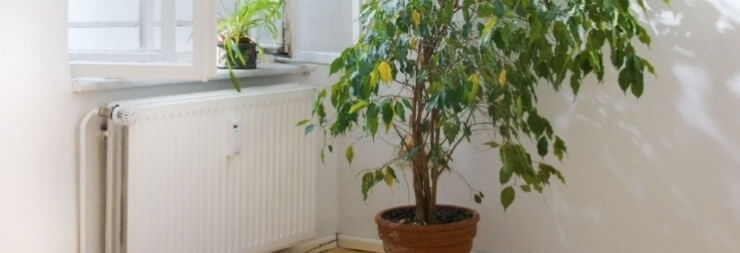Aside from our loved ones, there is perhaps nothing more important in our homes than the air we breathe. Though it’s easy to take for granted, poor indoor air quality can trigger a number of health problems, such as allergies and asthma. While the outdoors has the natural, pathogen-fighting power of the sun at its disposal, we must rely on different sources to keep our indoor air quality under control. As many of us are spending more time than ever inside, it is absolutely critical to make sure that your home’s air is healthy and safe to breathe. But what are the most effective ways to improve your home’s indoor air quality?
7 Ways to Improve Your Home’s Indoor Air Quality
1. Change Your Air Filter
Your air filters are essential for keeping bacteria and other pollutants from circulating in your home’s air. Over time, however, your air filter will become clogged with all the particles it collects from the air, so it must be changed at regular intervals. Cheaper options like fiberglass filters need to be changed roughly every 30 days, whereas more expensive, pleated filters may last 60 to 90 days. If you have pets or excessive dust in your home, you may need to change them more frequently. It’s also advised that you use a filter with a Minimum Efficiency Reporting Value (MERV) of at least eight. However, if anyone in your home suffers from allergies, you will want a filter with a MERV rating of at least 11.
2. Install a UV Light
Bacteria love to grow in cold, damp places, such as your air handler. When bacteria grow here, it is blown throughout your entire home, lowering your overall indoor air quality.
Ultraviolet lights can help to kill and prevent bacteria from growing inside your air handler. They work by breaking down organic molecular bonds. This can kill germs, bacteria, mold, and even viruses. UV lights are affordable and easy for a professional technician to install.
3. Add Plants to Your Home
Not only do plants add to your home’s decor, they can also change the way you breathe. Certain houseplants can actually purify your air, leaving your home fresh and clean. A study conducted by the National Aeronautics and Space Administration (NASA) and the Associated Landscape Contractors of America (ALCA) found that many common indoor plants are able to naturally and safely remove toxins from the air, such as benzene, formaldehyde, trichloroethylene, and even ammonia.
While each plant removes different pollutants, the most effective plants in the study included English ivy, peace lily, variegated snake plant, red-edged dracaena, and florist’s chrysanthemum. Adding any of these plants to your home is a great and natural way to improve your indoor air quality.
4. Give Your Home a Deep Cleaning
Chemicals, pet dander, and a host of other allergens can accumulate in household dust. Use a vacuum cleaner with strong rotating brushes and a HEPA filter to clean carpets. This will help ensure that high-traffic areas come clean and that dust will not be blown back into the room. Place floor mats at every door so family members and guests can wipe their feet to keep dirt and chemicals from entering your home.
5. Reduce VOCs
Volatile organic compounds (VOCs) are chemicals that vaporize at room temperature. They are commonly found in carpeting, furniture, and household cleaning products as well as tobacco smoke. While health effects will vary from product to product based on toxicity levels and time of exposure, some of the most common ones are:
- Headache
- Irritation of the eyes, nose, and/or throat
- Allergic reactions
- Skin irritation
- Dizziness
- Nausea
- Fatigue
In addition to making your home a smoke-free zone, try to reduce your usage of aerosol sprays or products that contain artificial fragrances. When using products that emit VOCs, open your doors and windows to increase ventilation, and reduce exposure.
6. Maintain Proper Humidity Levels
High humidity fosters the growth of mold, mildew, fungus, and bacteria. Dust mites also love moisture. An efficient HVAC system should pull moisture from the air to keep humidity levels between 30 and 50 percent. Most modern thermostats will display humidity readings, but if not you can purchase a hygrometer to get an accurate humidity reading. If your home’s humidity seems high, have your air conditioner serviced to ensure that the condensation line is not clogged. If the discharge line is blocked, the water pulled from the air can overflow the emergency drain pan and cause significant damage. While your AC unit dehumidifies the air as a natural part of its cooling process, in some cases you may need a dedicated dehumidifier to get humidity levels under control.
Related: 4 Signs Your Florida Home Needs a Dehumidifier
7. Get an Air Purifier
If you’ve done all of the steps above but are still having trouble maintaining high indoor air quality, you may need to invest in an air purifier. There are various types of technologies for these devices, such as ionization, HEPA filtration, electrostatic precipitation, UV light filtration, and much more. While each technology has its own advantages and disadvantages, they all aim to reduce and capture airborne pollutants. While an air purifier may not completely eliminate pathogens from the air, they do offer an extra level of protection for your indoor air quality and will reduce triggers for conditions like allergies and asthma.
Improve Your Indoor Air Quality with Colman Air
If you’re concerned about your home’s indoor air quality, contact Colman Heating & Air right away! Our experienced team of HVAC professionals has solutions to ensure that your home air is healthy all year long. Call today and begin improving your home’s indoor air quality.
24-HR Emergency Service: (321) 269-4565








